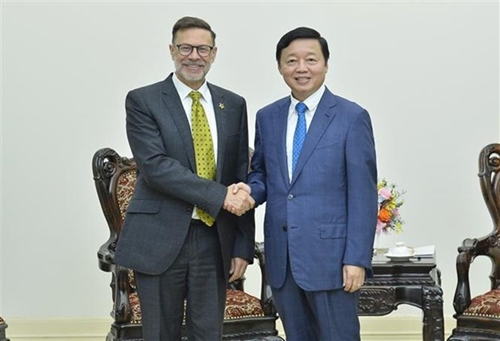Regarding Vietnam’s road-map for implementing the Just Energy Transition Partnership (JETP), Deputy Prime Minister Tran Hong Ha expressed his wish that Australia will participate in building a mechanism for coordination and join hands with developed and developing countries to achieve the net-zero target.
    |
 |
|
Deputy Prime Minister Tran Hong Ha (right) and Australian Ambassador to Vietnam Andrew Goledzinowski at their meeting in Hanoi on July 7 |
The Deputy PM proposed Australia share its experience and collaborate with Vietnam in research and technology transfer involving the production of green hydrogen and green ammonia from renewable energy at appropriate costs; the management of smart grids and energy transmission systems; and settlement of the financial resource challenge for transition from fossil energy to renewables, among many others.
With their similarities in climate change adaptation, water resource management, and desertification prevention, Deputy Prime Minister Tran Hong Ha believed that both sides could study and select specific projects to exchange, share experiences, transfer technology, and improve related legal frameworks.
Vietnam hopes that Australia, with its experience in building green financial mechanisms for climate change adaptation and environmental protection, can provide advice and assistance in developing a carbon credit market for the Southeast Asian country, Deputy Prime Minister Tran Hong Ha said.
He highly appreciated the support from Australian organizations and partners for building policies and regulations on geology, minerals, and energy transition in Vietnam so far.
For his part, Goledzinowski affirmed that the Australian Government highly valued Vietnam's commitments and was ready to assist the nation’s road-map for energy transition and achieving net-zero greenhouse gas emissions by 2050.
He told his host that Australian businesses are very interested in the orientation of renewable energy development in Vietnam’s national power development plan for 2021-2030 with a vision until 2050, as well as the application of advanced and modern technologies in the exploration, reserves assessment, exploitation, and processing of valuable minerals in Vietnam.
Source: VNA